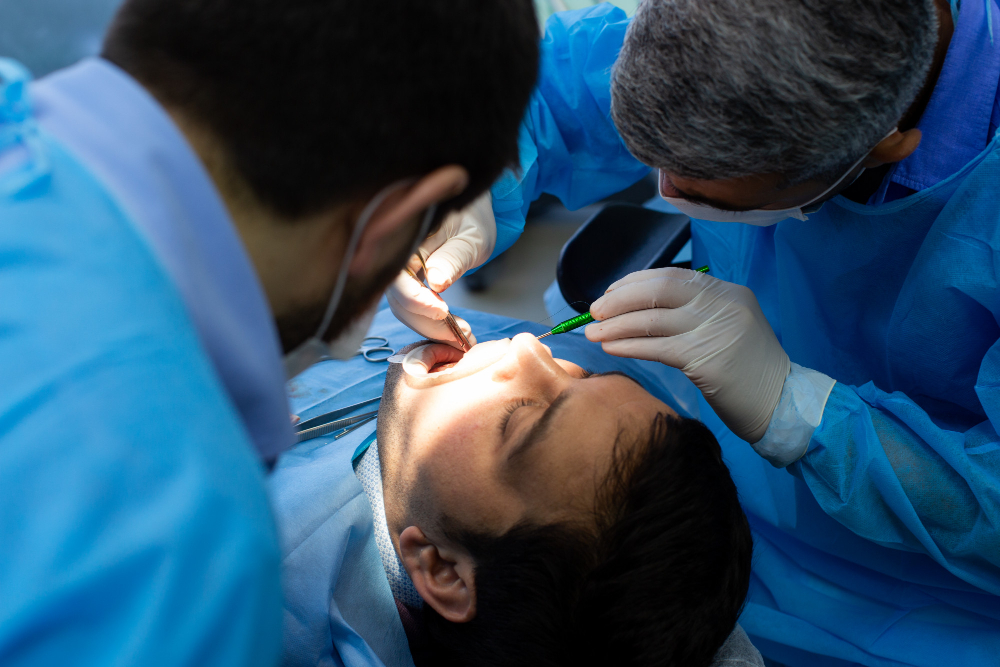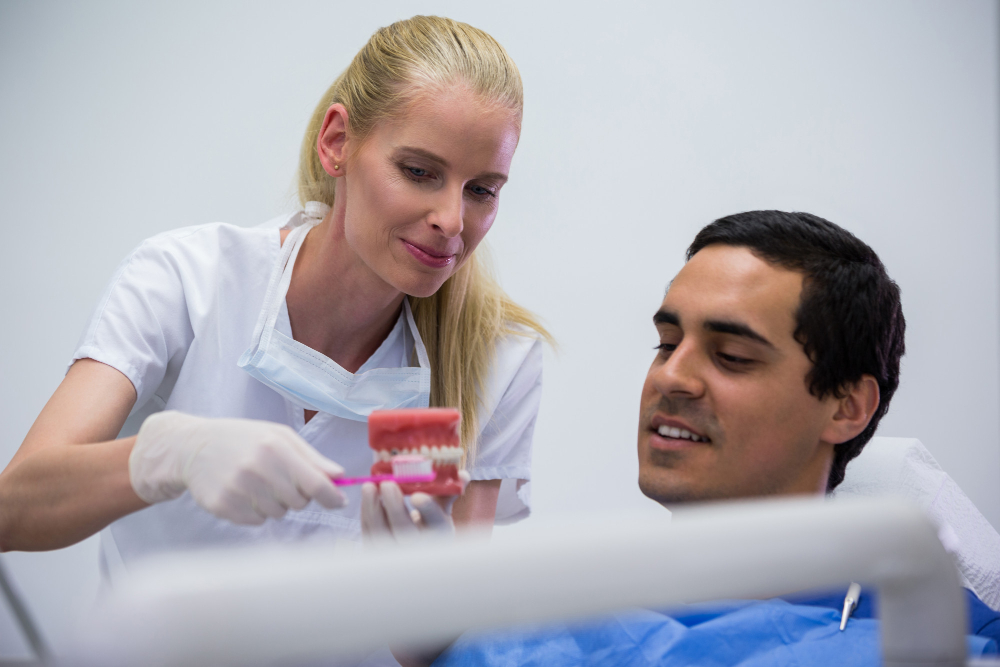TL;DR
- Gum disease is an infection impacting the structures supporting your teeth.
- There are two main stages, namely gingivitis and periodontitis:
- Gingivitis:
- Gingivitis symptoms include red, swollen, or bleeding gums and bad breath.
- This stage can be reversed if caught early.
- Treatments include regular brushing, flossing, dental visits, eating healthy, and dental procedures like scaling and root planing.
- Periodontitis:
- Advanced gum disease, known as periodontitis, involves underlying bone.
- This stage may not be fully reversible and may require surgery, like bone grafting and flap surgery.
- Prevention involves brushing twice daily, flossing, healthy eating and regular dental visits.
What is Gum Disease?
Around 40% of adults in the United States experience some level of gum disease. The condition develops when the bones and tissues that hold and protect your teeth become infected. It starts with gingivitis, which is the early stage marked by red, swollen, or bleeding gums. If not treated, it can progress to periodontitis. This is a more serious stage that can damage the gums and supporting bone.
This raises an important question: can gum disease be reversed? The answer depends on how early it is detected and treated. In its early stage, gingivitis can often be reversed. However, once it has advanced to periodontitis, the damage is often irreversible. This is why early attention to signs is important. Let us take a closer look at what causes gum disease, common symptoms, treatment options available, and how you can prevent it.
What are the Causes of Gum Disease?
Several factors can lead to gum disease, and knowing them can help you protect your oral health. As per our experts at Periodontal Specialists, here are the main causes:
- Not brushing and flossing properly, which allows plaque to accumulate on the teeth
- Plaque turning into hard tartar if not cleaned
- Smoking or chewing tobacco, which weakens the gums
- Excessive sugar consumption or having a poor diet can feed bacteria that cause gum problems
- Health conditions like diabetes that affect your gums
- Hormonal changes during puberty, pregnancy, or menopause
- Stress, which lowers the body’s ability to fight infections
- Family history or genetics that make some people more likely to develop gum disease
Symptoms of Gum Disease
Gum disease can show different signs, depending on how advanced it is. Here are the key symptoms you should watch out for:
Early Symptoms (Gingivitis)
- Red, swollen gums that may feel sore
- Gums that bleed during brushing or flossing
- Bad breath that does not go away easily
- Tenderness along the gumline
Advanced Symptoms (Periodontitis)
- Gums that are pulling away from the teeth (receding gums)
- Loose or shifting teeth
- Pain when chewing food
- Noticeable gaps between teeth and gums (pockets)
- Persistent bad taste in the mouth
- Loss of supporting bone in severe cases
Can Gum Disease be Reversed?
With timely dental care, professional cleaning, and consistent oral hygiene habits, gingivitis can often be reversed. However, once it advances to periodontitis, the damage cannot be fully reversed. With proper care, though, periodontitis can be controlled and stopped from getting worse.
Professional Treatments for Gum Disease
Treatments for gum disease depend on how severe the condition is. Here are some common options:
- Scaling and Root Planing: A deep cleaning method that removes plaque and tartar under the gumline.
- Antibiotic Therapy: Medicines may be given in the form of gels, rinses, or pills to fight infections.
- Flap Surgery: This treatment helps clean deep pockets around the teeth by gently lifting the gums.
- Bone Grafting: A procedure to restore bone lost due to gum disease, providing support and stability for the teeth.
- Soft Tissue Grafts: Tissue may be added to repair receding gums and cover exposed roots.
- Laser Therapy: It may be used to target and remove infected gum tissue while reducing bacterial growth.
Many patients also ask us, “Can early gum disease be reversed at home?” Yes, in many cases, gingivitis can be managed and even reversed at home, but advanced stages require long-term management.

Prevention Tips for Healthy Gums
Why wait to ask, “Can gum disease be reversed?” when you can prevent it in the first place? Here are some simple prevention tips everyone can follow:
- Brush twice every day with fluoride toothpaste to effectively remove plaque
- Floss daily to clean food and bacteria from between teeth
- Use an antibacterial mouthwash to keep germs under control
- Schedule a dental checkup every 6 months to maintain oral health
- Eat a balanced diet rich in fruits, vegetables, and calcium for stronger teeth and gums
- Limit sugary snacks and drinks that increase plaque buildup
- Avoid smoking or chewing tobacco since it makes gum disease worse
- Drink plenty of water to clear away food particles and keep the mouth moist
- Pay attention to any early signs, like swollen gums or bleeding, and act quickly

Final Thoughts
So, can gum disease be reversed? In the early stage, yes, it can often be managed with better oral care and timely checkups. Regular brushing, flossing, and professional cleanings play a big role in halting the damage. Visiting a gum disease specialist is important if symptoms like bleeding gums or swelling appear.
If gum disease has advanced, reversing it becomes harder, but prompt treatment can still control it. At Periodontal Specialists, we use modern dental technology and techniques to safeguard your gum health. So, if you are looking for a reliable periodontal dentist in Rochester, Northfield, Red Wing, Owatonna, or Winona, schedule a consultation with us to discuss your treatment options.
FAQs
Can gum disease be completely reversed?
Gum disease can be reversed if caught very early. Daily brushing, flossing, and routine dental checkups can help heal gums and bring them back to health. However, advanced stages cannot be fully reversed but can be managed to prevent further damage.
What are the early signs of gum disease?
The first signs of gum disease include redness, swelling, and bleeding of the gums. Other common symptoms are persistent bad breath and receding gums. These signs mean teeth and gums need extra care to stop further damage.
How does scaling and root planing help in gum disease treatment?
Scaling removes harmful plaque and tartar buildup from the surfaces of your teeth, including areas below the gumline. Root planing smooths the surfaces of tooth roots, allowing the gums to reattach and heal more effectively.
When is surgery necessary for gum disease?
Surgery for gum disease is needed when the condition has advanced or affects the deeper areas of the gums. It helps remove harmful bacteria and fix damaged gums and bones.
When should I see a dentist for gum problems?
See a dentist if your gums are red, swollen, bleed, or hurt. Also, visit a dentist if bad breath, loose teeth, or changes in your bite occur. Early treatment stops further damage.




